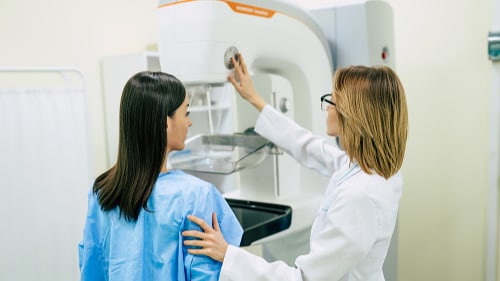At a glance
- Mammograms use x-ray beams to create images of the inside of the breast.
- These images help diagnose breast cancer and other conditions.
- Your healthcare provider may recommend a mammogram when they believe that the benefits outweigh the risks for your health.

The basics
Mammograms for breast cancer screening can help find breast cancer early—before there are any signs or symptoms. Mammograms use x-ray beams (a form of ionizing radiation) to create images of the inside of the breast. Healthcare providers use mammograms to check for breast cancer and other conditions in the breast of both men and women.
Finding and treating cancer early can greatly improve the chances of full recovery and may mean shorter and less invasive treatments. Some risks from mammograms include false results and exposure to a small dose of ionizing radiation during the procedure. We all are exposed to ionizing radiation every day from the natural environment. However, additional exposures can lead to an increase in the possibility of developing cancer later in life.
What you should know
Your healthcare provider may recommend a mammogram for breast cancer screening or for other symptoms in the breast. Symptoms like a lump, pain, changes in breast skin texture, or nipple discharge can all be reasons for concern.
The United States Preventive Services Task Force recommends:
- Mammograms every two years for women who are 50-74 years old and are at average risk for breast cancer.
- Women who are 40-49 years old should talk to their healthcare provider about when or how often to get a mammogram based on personal risk and health history.
Work with your healthcare provider to decide on the best screening process and schedule for you. Your healthcare provider may recommend a mammogram when they believe that the benefits outweigh the risks for your health.
What to expect
Before the procedure
- Make sure to let your healthcare provider or radiologist (medical professional specially trained in radiation procedures) know if you are pregnant or think you could be pregnant.
- Do not wear deodorant, talcum powder, or lotion under your arms or on your breast area on the day of the exam.
- The radiologist will tell you what clothing or other items you are wearing (such as jewelry or eyeglasses) to remove so they can get clear images.
During the procedure
- Your breast will be placed on a special platform and compressed with a clear plastic paddle. You may experience discomfort.
- You will be asked to change positions between images. The routine views are a top-to-bottom view and an angled side view. The process will be repeated for the other breast.
- You must hold very still and may be asked to hold your breath for a few seconds while the x-ray picture is taken to reduce the possibility of a blurred image.
- The information collected will be processed to show the structures in the breast and any abnormalities.
Risks and benefits
Benefits
Mammograms:
- Are specifically designed to look for breast diseases and can find cancers up to three years before they can be felt. Early detection helps successful treatment.
- Can track changes in breast tissue over time.
- Help guide treatment when cancer is present.
Risks
Results can sometimes be false:
- A false-positive test, one that indicates you may have cancer when you truly do not, may lead to extra expenses, testing, and stress.
- A false-negative test, one that says you do not have any cancer when you truly do, may delay your diagnosis and treatment.
If your doctor suspects your results could be false, they may repeat testing. They may also order a different type of test like an ultrasound. This is especially common in those who have dense breasts.
Resources
American College of Radiology
CDC
FDA
Image Gently
National Cancer Institute
U.S. Environmental Protection Agency (EPA)
- RadTown USA Medical X-Rays
- Radiation Protection Guidance for Diagnostic and Interventional X-Ray Procedures
U.S. National Library of Medicine
